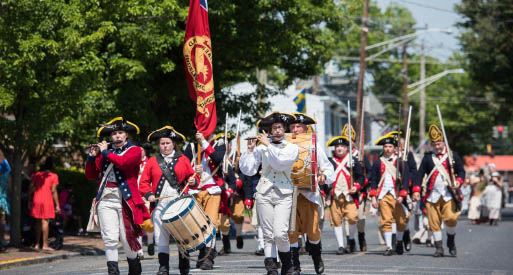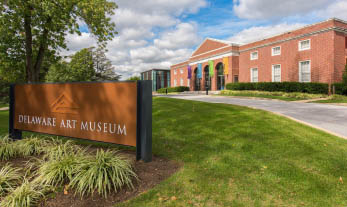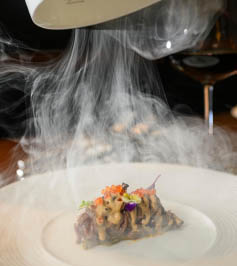WONDROUS WILMINGTON

Might you need…
A “traveling bag” that can transform into a stool, just in case you’re stuck for hours in an airport holding pen? A musical keyboard instrument that converts to a bed, because doesn’t every apartment in New York City need an extra guest room?
Such is the stuff, to paraphrase Shakespeare, that dreams are made of and these are the fascinating fruits of cornucopic minds that see things not as they are, but as they might be—machinery that can solve problems, improve existing solutions, or, at the very least, simplify life.
The visionaries who fantasized first and then fabricated these inventions into reality are, respectively, one Victor Percheron, who patented his inventive suitcase/stool in 1866 and John McDonald, who knew that a two-fer whimsical piece of furniture would sell, even in 1869.
This duo represents but two among some 5,000 models of machinery, gadgets, and gizmos, all in miniature, that are part of the American Patent Model Collection at Hagley Museum and Library in Wilmington, Delaware. Encouraging ingenuity in a budding America was so important to the nation’s growth that in 1790 President George Washington himself signed the first patent legislation.
The Hagley is located on 235 acres along the banks of the Brandywine River and is the site of the original gunpowder works founded by French émigré Éleuthère Irénée du Pont de Nemours, who arrived here with his father and brother in 1800. This site would ultimately become the bedrock of today’s DuPont Company. (Remember the logo: Better Things for Better Living...Through Chemistry.) It is not surprising that the DuPont organization and personal, family history punctuate many of the historic sites in Wilmington.
Equally as fascinating as Hagley, is the legendary Winterthur Museum, Garden & Library. The home to several generations of du Ponts, it is today considered one of the greatest repositories of American furniture and decorative arts, with a collection of 90,000 objects displayed in the manse’s vast 175 rooms (not all are open to the public). One butler’s pantry is stocked solely with candlesticks and candelabra, floor to ceiling. Situated on close to 1,000 acres, comprising glorious meadowlands, woods, waterways, and woodlands, Winterthur offers a glimpse of a privileged life in early America.
As magnificent as Winterthur is, I loved even more, the Nemours Estate, home to Alfred I. du Pont, great-grandson of E. I. It is a “modest” dwelling with a mere 102 rooms on a scant 100 acres, but with a showy garden modeled after the grounds of the Palace of Versailles, including fountains, mazes, towers, monuments, and nature trails. Twin bowling alleys, a billiards room, a room with floor-to-ceiling refrigeration units (Alfred had been a student at M.I.T. and embraced the cutting-edge technology of the period), and a stately garage, which still houses a 1960 Rolls Royce Phantom V Town Car, one of just ten that were manufactured in a single year.
The Brandywine Conservancy and Museum of Art houses a distinguished collection of nineteenth- and twentieth-century American art in a renovated nineteenth-century mill. The extraordinary site emphasizes the Brandywine Conservancy’s commitment to the preservation of the natural, cultural, and scenic resources of the region. The crowning jewel: On the museum’s campus is the home and studio of N. C. Wyeth, that appears to be precisely as the artist left it. And, naturally, the museum holds many works by N.C., Andrew, and Jamie.

The Delaware Art Museum, with 12,000 works, including historical and contemporary American art, British Pre-Raphaelite art, and American illustrations, has at its core, the works of the renowned Howard Pyle. I could go on and on about the museums and historic homes in the area: Amstel House Museum, the Sanderson Museum, and the Delaware Children’s Museum, among the many.
A scant forty minutes’ drive away, in Kennett Square, Pennsylvania, but still in the Brandywine Valley, is the legendary Longwood Gardens. Originally a Quaker farmstead and arboretum, Longwood was transformed by the forward-thinking Pierre S. du Pont, who purchased the land in 1906, undertaking the stewardship of the gardens, saving the stately trees from an ever-eager saw. He did not intend to create Longwood Gardens, as we know it today, but by 1921, when the Conservatory opened, it was impossible to keep guests away and, today, the grounds host 1.6 million visitors a year.
Longwood comprises 1,100 acres of dazzling gardens, woodlands, meadows, fountains, a 10,010-pipe Aeolian organ, and the grand conservatory. In a word, it is majestic, showcasing the efforts of inventive and dedicated renowned landscape designers, horticulturists, and architects. Recently, Longwood undertook a major revision, called Longwood Reimagined, focused on 17 acres of the property, reconfigured to include, among other structures, another grand conservatory (32,000 square feet) and a very-in-demand restaurant, aptly named 1906, which is run by the eminent Restaurant Associates. Besides top-tier cuisine, the establishment features floor-to-ceiling, arched windows overlooking the imperial Main Fountain Garden, and elegant furnishings (crafted from reclaimed wood from Longwood trees).


You’ll find toothsome food in other eateries in the area: Buckley’s Tavern, a local legend, was originally a historic home and blacksmith shop, dating back to 1817. Converted to a taproom and ice cream shop in the 1930s, proprietor Dennis Buckley transformed it some 75 years ago. Bardea, a downtown local fave, has an enticing menu, and not surprisingly, was named a James Beard New Restaurant semifinalist in 2019; in that same year, its chef, Antimo DiMeo, garnered the Restaurant Industry Rising Star appellation from the Delaware Restaurant Association.
And, of course, you’ll need a roof over your head, and there is no better choice than the celebrated, restored Hotel du Pont, a member of the Historic Hotels of America, and a grand dame in the city. Formerly, the building was home to the corporate offices for the DuPont Company, constructed at the behest of Pierre S. du Pont. In 1913, this dowager was the destination for anyone who was anyone, including aviators Amelia Earhart and Charles Lindbergh. Do not pass up an opportunity to dine in the restaurant, Le Cavalier, which features food with a modern French flair, influenced by the flavors of North Africa and Provence.
For more information: visitwilmingtonde.com






